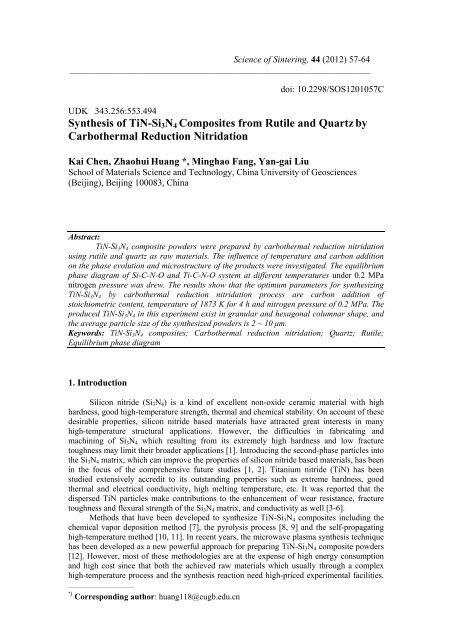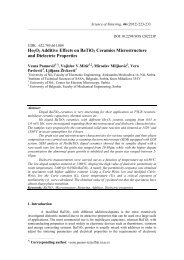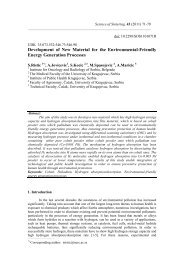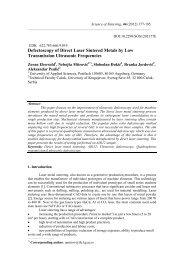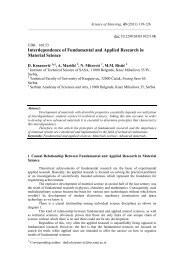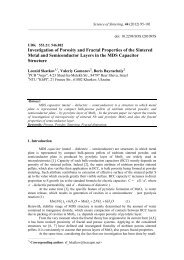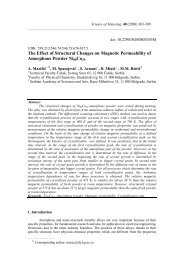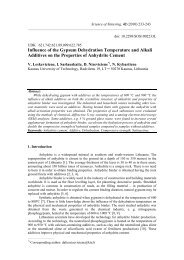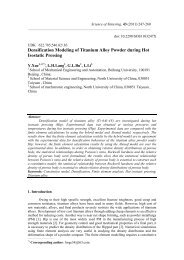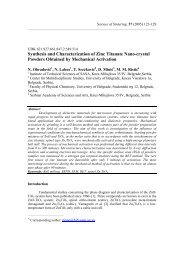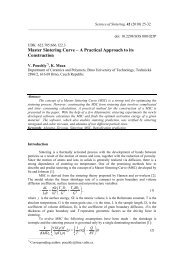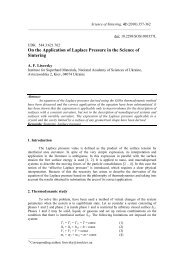Synthesis of TiN-Si3N4 Composites from Rutile and ... - doiSerbia
Synthesis of TiN-Si3N4 Composites from Rutile and ... - doiSerbia
Synthesis of TiN-Si3N4 Composites from Rutile and ... - doiSerbia
Create successful ePaper yourself
Turn your PDF publications into a flip-book with our unique Google optimized e-Paper software.
Science <strong>of</strong> Sintering, 44 (2012) 57-64<br />
________________________________________________________________________<br />
doi: 10.2298/SOS1201057C<br />
UDK 343.256:553.494<br />
<strong>Synthesis</strong> <strong>of</strong> <strong>TiN</strong>-Si 3 N 4 <strong>Composites</strong> <strong>from</strong> <strong>Rutile</strong> <strong>and</strong> Quartz by<br />
Carbothermal Reduction Nitridation<br />
Kai Chen, Zhaohui Huang *, Minghao Fang, Yan-gai Liu<br />
School <strong>of</strong> Materials Science <strong>and</strong> Technology, China University <strong>of</strong> Geosciences<br />
(Beijing), Beijing 100083, China<br />
Abstract:<br />
<strong>TiN</strong>-Si 3 N 4 composite powders were prepared by carbothermal reduction nitridation<br />
using rutile <strong>and</strong> quartz as raw materials. The influence <strong>of</strong> temperature <strong>and</strong> carbon addition<br />
on the phase evolution <strong>and</strong> microstructure <strong>of</strong> the products were investigated. The equilibrium<br />
phase diagram <strong>of</strong> Si-C-N-O <strong>and</strong> Ti-C-N-O system at different temperatures under 0.2 MPa<br />
nitrogen pressure was drew. The results show that the optimum parameters for synthesizing<br />
<strong>TiN</strong>-Si 3 N 4 by carbothermal reduction nitridation process are carbon addition <strong>of</strong><br />
stoichiometric content, temperature <strong>of</strong> 1873 K for 4 h <strong>and</strong> nitrogen pressure <strong>of</strong> 0.2 MPa. The<br />
produced <strong>TiN</strong>-Si 3 N 4 in this experiment exist in granular <strong>and</strong> hexagonal columnar shape, <strong>and</strong><br />
the average particle size <strong>of</strong> the synthesized powders is 2 ~ 10 μm.<br />
Keywords: <strong>TiN</strong>-Si 3 N 4 composites; Carbothermal reduction nitridation; Quartz; <strong>Rutile</strong>;<br />
Equilibrium phase diagram<br />
1. Introduction<br />
Silicon nitride (Si 3 N 4 ) is a kind <strong>of</strong> excellent non-oxide ceramic material with high<br />
hardness, good high-temperature strength, thermal <strong>and</strong> chemical stability. On account <strong>of</strong> these<br />
desirable properties, silicon nitride based materials have attracted great interests in many<br />
high-temperature structural applications. However, the difficulties in fabricating <strong>and</strong><br />
machining <strong>of</strong> Si 3 N 4 which resulting <strong>from</strong> its extremely high hardness <strong>and</strong> low fracture<br />
toughness may limit their broader applications [1]. Introducing the second-phase particles into<br />
the Si 3 N 4 matrix, which can improve the properties <strong>of</strong> silicon nitride based materials, has been<br />
in the focus <strong>of</strong> the comprehensive future studies [1, 2]. Titanium nitride (<strong>TiN</strong>) has been<br />
studied extensively accredit to its outst<strong>and</strong>ing properties such as extreme hardness, good<br />
thermal <strong>and</strong> electrical conductivity, high melting temperature, etc. It was reported that the<br />
dispersed <strong>TiN</strong> particles make contributions to the enhancement <strong>of</strong> wear resistance, fracture<br />
toughness <strong>and</strong> flexural strength <strong>of</strong> the Si 3 N 4 matrix, <strong>and</strong> conductivity as well [3-6].<br />
Methods that have been developed to synthesize <strong>TiN</strong>-Si 3 N 4 composites including the<br />
chemical vapor deposition method [7], the pyrolysis process [8, 9] <strong>and</strong> the self-propagating<br />
high-temperature method [10, 11]. In recent years, the microwave plasma synthesis technique<br />
has been developed as a new powerful approach for preparing <strong>TiN</strong>-Si 3 N 4 composite powders<br />
[12]. However, most <strong>of</strong> these methodologies are at the expense <strong>of</strong> high energy consumption<br />
<strong>and</strong> high cost since that both the achieved raw materials which usually through a complex<br />
high-temperature process <strong>and</strong> the synthesis reaction need high-priced experimental facilities.<br />
_____________________________<br />
*) Corresponding author: huang118@cugb.edu.cn
58<br />
K.Chen et al. /Science <strong>of</strong> Sintering, 44 (2012) 57-64<br />
___________________________________________________________________________<br />
It is well known that powders <strong>of</strong> carbonitrides <strong>and</strong> nitrides can be economically produced by<br />
carbothermal reduction nitridation (CRN) processes. CRN has attracted great interests as the<br />
most cost-efficient method to synthesize Si 3 N 4 based materials <strong>from</strong> natural minerals [13, 14].<br />
The purpose <strong>of</strong> this paper is to obtain the cost-effective synthesis <strong>of</strong> <strong>TiN</strong>-Si 3 N 4<br />
composite powders by using cheaper starting material <strong>and</strong> synthesizing method. In this study,<br />
rutile <strong>and</strong> quartz were used as the raw materials for the synthesis <strong>of</strong> <strong>TiN</strong>-Si 3 N 4 composites by<br />
CRN process. The influence <strong>of</strong> temperature <strong>and</strong> carbon addition on the phase evolution <strong>and</strong><br />
the microstructure <strong>of</strong> the products were investigated. The equilibrium phase diagram <strong>of</strong> Si-C-<br />
N-O <strong>and</strong> Ti-C-N-O system at different temperatures under 0.2 MPa nitrogen pressure was<br />
drew, <strong>and</strong> the optimum experimental conditions for synthesizing <strong>TiN</strong>-Si 3 N 4 composite<br />
powders were obtained.<br />
2. Experimental Procedure<br />
The raw starting materials are as follows: rutile powder (grain size < 0.5 μm, purity 95<br />
wt %), quartz powder (grain size < 38 μm, chemical composition (wt %): SiO 2 : 97.8, Al 2 O 3 :<br />
0.63, Fe 2 O 3 : 0.33, CaO: 0.08). Carbon black powder (grain size < 25 μm, carbon content: 99<br />
wt %) <strong>and</strong> N 2 (purity 99.99%) were employed as reducer <strong>and</strong> reactive gas, respectively.<br />
Quartz powder <strong>and</strong> rutile powder with a weight ratio <strong>of</strong> 90 : 10 were mixed, then carbon black<br />
with mass additions (wt %) <strong>of</strong> 39.0, 42.9, 58.5 <strong>and</strong> 78.0 were added into the mixtures. The<br />
mixtures were mixed <strong>and</strong> milled with Al 2 O 3 balls in anhydrous alcohol at 200 rpm for 6 h,<br />
then dried at 353 K. And the powder mixture samples with different carbon additions were<br />
marked as S1, S2, S3 <strong>and</strong> S4, respectively. Finally, the mixed powders were placed in a BNcoated<br />
graphite crucible, <strong>and</strong> CRN reactions were carried out in a tube furnace at different<br />
temperatures (1723 K, 1773 K, 1823 K <strong>and</strong> 1873 K) for 4 h under 0.2 MPa nitrogen pressure.<br />
The samples were slowly cooled down to room temperature. Then the samples were sintered<br />
at 973 K for 1 h to have a decarburization process.<br />
The crystalline phases were determined by X-ray diffraction (XRD; D8 Advance<br />
diffractometer, Germany), using Cu Kα 1 radiation (λ = 1.5406 Å) with a scanning rate <strong>of</strong> 8°<br />
min -1 . The particle size <strong>and</strong> microstructure <strong>of</strong> the final products were examined by scanning<br />
electron microscopy (SEM; JEM-6460LV microscope, Japan) <strong>and</strong> energy dispersive<br />
spectroscopic (EDS; Oxford Inca X-sight, UK).<br />
3. Results <strong>and</strong> Discussion<br />
3.1 Thermodynamic considerations<br />
In this experimental condition, the synthesis process <strong>of</strong> <strong>TiN</strong>-Si 3 N 4 composite powder<br />
by CRN reaction is very complex <strong>and</strong> involves many chemical reactions. The final products<br />
<strong>of</strong> the nitridation reaction <strong>of</strong> rutile are <strong>TiN</strong> <strong>and</strong> TiC, though several intermediate crystalline<br />
phases can be obtained in the CRN process. The overall reactions during the CRN process <strong>of</strong><br />
rutile are as follows:<br />
TiO 2<br />
(s) + 3C(s) = TiC(s) + 2CO(g)<br />
(1)<br />
1<br />
TiO2 (s) + 2C(s) + N2(g)<br />
= <strong>TiN</strong>(s) + 2CO(g)<br />
(2)<br />
2<br />
1<br />
TiC(s)<br />
+ N<br />
2<br />
(g) = <strong>TiN</strong>(s) + C(s)<br />
(3)<br />
2<br />
From the results <strong>of</strong> the investigations <strong>of</strong> the solid intermediate reaction products during<br />
the forming process <strong>of</strong> <strong>TiN</strong>, the reaction sequence TiO 2 →Ti 4 O 7 → Ti 3 O 5 → Ti 2 O 3 →
K. Chen et al./Science <strong>of</strong> Sintering, 44 (2012) 57-64<br />
59<br />
___________________________________________________________________________<br />
Ti(N,O) → <strong>TiN</strong> was established [15]. However, there is some controversy on the reaction<br />
mechanism <strong>of</strong> TiC formation in the CRN reactions. Some authors claim that this is due to<br />
solid-solid mechanism by the direct reaction <strong>of</strong> TiO 2 with C mixture particles, while others<br />
are in favor <strong>of</strong> the Boudeward vapor-solid approach by the reaction <strong>of</strong> TiO 2 with CO [16, 17].<br />
With the change <strong>of</strong> the raw materials composition, the reaction products maybe<br />
involve Si 2 N 2 O, Si 3 N 4 <strong>and</strong> SiC. The chemical reactions are likely to occur during the<br />
synthesis process are as follows:<br />
SiO 2<br />
(s) + 3C(s) = SiC(s) + 2CO(g)<br />
(4)<br />
SiO (s) + 6C(s) + 2N (g) = Si N (s) 6CO(g)<br />
(5)<br />
3<br />
2 2<br />
3 4<br />
+<br />
2SiO<br />
2<br />
(s) 3C(s) + N<br />
2<br />
(g) = Si<br />
2N<br />
2O(s)<br />
+<br />
+ 3CO(g)<br />
(6)<br />
1<br />
3<br />
1 1<br />
Si2 N2O(s)<br />
+ C(s) = SiC(s) + N2(g)<br />
+ CO(g)<br />
2<br />
2<br />
2 2<br />
(7)<br />
3<br />
1 3<br />
3<br />
Si2 N2O(s)<br />
+ N2(g)<br />
+ C(s) = <strong>Si3N4</strong>(s)<br />
+ CO(g)<br />
2<br />
2 2<br />
2<br />
(8)<br />
1<br />
2<br />
Si3 N4(s)<br />
+ C(s) = SiC(s) + N2(g)<br />
3<br />
3<br />
(9)<br />
It is generally accepted that the CRN reactions (1) <strong>and</strong> (2) <strong>of</strong> quartz occurs through<br />
step by step mechanism, where SiO acts as a gaseous intermediate [17, 18]. SiO can be<br />
formed by solid-solid reaction (10) <strong>and</strong> vapor-solid reaction (11).<br />
SiO 2<br />
(s) + C(s) = SiO(g) + CO(g)<br />
(10)<br />
SiO<br />
2<br />
(s) + CO(g) = SiO(g) + CO2<br />
(g)<br />
(11)<br />
Then, Si 3 N 4 can be produced according to the carbonitriding reactions (12) <strong>and</strong> (13).<br />
Under normal conditions, α-Si 3 N 4 was produced by CRN process. But the eutectic reaction<br />
occurred due to the effect <strong>of</strong> the liquid phases <strong>of</strong> TiO 2 <strong>and</strong> Fe 2 O 3 , <strong>and</strong> led to the formation <strong>of</strong><br />
β-Si 3 N 4 instead <strong>of</strong> α-Si 3 N 4 [19].<br />
2<br />
1<br />
SiO(g)<br />
+ N<br />
2<br />
(g) + C(s) = Si3N<br />
4<br />
(s) + CO(g)<br />
(12)<br />
3<br />
3<br />
2<br />
1<br />
SiO(g)<br />
+ N<br />
2<br />
(g) + CO(g) = Si3N<br />
4<br />
(s) + CO<br />
2<br />
(g)<br />
(13)<br />
3<br />
3<br />
The formation reaction <strong>of</strong> SiC occurs via the vapor-solid approach or by the gas phase<br />
reaction:<br />
Si (g) + 2C(s) = SiC(s) + CO(g)<br />
(14)<br />
SiO(g)<br />
+ 3CO(g) = SiC(s) + 2CO2<br />
(g)<br />
(15)<br />
Fig.1 shows the equilibrium phase diagram <strong>of</strong> the stable solid phases in Si-C-N-O <strong>and</strong><br />
Ti-C-N-O system at different temperatures under 0.2 MPa nitrogen pressure. It is constructed<br />
1 P<br />
by calculating the relationship between <strong>and</strong> ln(<br />
CO<br />
RT ) <strong>of</strong> reactions (1) ~ (9). It is seen in<br />
T<br />
θ<br />
P<br />
Fig.1 that Si 2 N 2 O exists as a stable phase at 1406 K to 1876 K when the P CO was 0.01 MPa.<br />
Besides, Si 3 N 4 keeps stable under a maximum permissible P CO <strong>of</strong> 1.78×10 -3 MPa at 1794K.<br />
This indicates that Si 3 N 4 can coexist with <strong>TiN</strong> under a smaller P CO condition. Therefore, the<br />
<strong>TiN</strong>-Si 3 N 4 composites can be obtained by optimizing the reaction conditions such as reaction<br />
temperature, atmosphere <strong>and</strong> gas partial pressure. In this experiment, increasing the velocity<br />
<strong>of</strong> the flow <strong>of</strong> nitrogen was conducted at the temperatures above 1273 K to reduce the partial<br />
pressure <strong>of</strong> CO.
60<br />
K.Chen et al. /Science <strong>of</strong> Sintering, 44 (2012) 57-64<br />
___________________________________________________________________________<br />
Fig.1 Equilibrium phase diagram <strong>of</strong> Si-C-N-O <strong>and</strong> Ti-C-N-O system.<br />
3.2 Effect <strong>of</strong> the reaction temperature<br />
Fig. 2 shows the results <strong>of</strong> XRD measurements on sample S2 after heat-treatment at<br />
different temperatures for 4 h. It can be seen that cristobalite, β-SiC, Ti(C,N) <strong>and</strong> Si 2 N 2 O were<br />
formed in the products when the reaction temperature increased to 1723 K. With the increase<br />
<strong>of</strong> the reaction temperature, the diffraction peak intensity <strong>of</strong> Si 2 N 2 O increased gradually,<br />
while the intensity <strong>of</strong> cristobalite dropped. At temperatures above 1773 K, an increasing<br />
number <strong>of</strong> Si 2 N 2 O, β-SiC <strong>and</strong> <strong>TiN</strong> were observable. β-Si 3 N 4 was obtained at 1823 K in the<br />
products <strong>and</strong> became the predominant crystalline phase, while the diffraction peak intensity <strong>of</strong><br />
β-SiC phase was weaker than that <strong>of</strong> others <strong>and</strong> the cristobalite phase was barely discernible.<br />
Fig.2 XRD patterns <strong>of</strong> S2 sintered at different temperatures.<br />
It is inferred that β-SiC <strong>and</strong> Si 2 N 2 O reacted <strong>and</strong> formed β-Si 3 N 4 following as the<br />
carbonitriding reactions (4) ~ (6), respectively. The product synthesized at 1823 K includes β-
K. Chen et al./Science <strong>of</strong> Sintering, 44 (2012) 57-64<br />
61<br />
___________________________________________________________________________<br />
Si 3 N 4 , Si 2 N 2 O, β-SiC <strong>and</strong> <strong>TiN</strong>. The β-SiC phase vanished in the sample obtained at 1873 K,<br />
differing <strong>from</strong> the results <strong>of</strong> the corresponding samples derived <strong>from</strong> the carbon addition. β-<br />
Si 3 N 4 entirely replaced Si 2 N 2 O <strong>and</strong> the major products formed at 1873 K were β-Si 3 N 4 <strong>and</strong><br />
<strong>TiN</strong>. In addition, the diffraction peak intensity <strong>of</strong> β-Si 3 N 4 or <strong>TiN</strong> is higher than that obtained<br />
at 1723 K, 1773 K or 1823 K. This indicates that increasing the reaction temperature can<br />
promote the formation <strong>of</strong> β-Si 3 N 4 <strong>and</strong> <strong>TiN</strong>. The optimum temperature for the synthesis <strong>of</strong> high<br />
<strong>TiN</strong>-Si 3 N 4 composites was 1873 K for 4 h.<br />
The SEM micrographs <strong>and</strong> the EDS patterns <strong>of</strong> the products <strong>of</strong> sample S2 sintered at<br />
different temperatures are shown in Fig. 3. Fig. 3(a) shows the SEM micrographs <strong>of</strong> sample<br />
S2 heated at 1823 K. The average particle size <strong>of</strong> the globular agglomerates is 1 ~ 5 μm.<br />
Besides, many holes in the middle <strong>of</strong> the agglomerated grains as an open hollow structure are<br />
apparent in the samples. It is believed that these holes were resulted <strong>from</strong> the release <strong>of</strong><br />
gaseous reduction product such as CO <strong>and</strong> SiO during the further reduction. EDS analysis<br />
results in Fig. 3(c) <strong>and</strong> XRD pattern <strong>of</strong> sample S2 heated at 1823 K in Fig. 2 indicate that the<br />
globular agglomerates as shown in Fig. 3(a) are composed <strong>of</strong> β-Si 3 N 4 , Si 2 N 2 O <strong>and</strong> <strong>TiN</strong>. Fig.<br />
3(b) shows the short columnar or hexagonal morphology <strong>of</strong> β-Si 3 N 4 synthesized at 1873 K. It<br />
can also be observed <strong>from</strong> Fig. 3(d) that titanium was detected in the area <strong>of</strong> the short<br />
columnar grain. This indicates that a small amount <strong>of</strong> <strong>TiN</strong> was formed in the products <strong>of</strong><br />
sample S2. And it is proposed that solid solutions between <strong>TiN</strong> <strong>and</strong> Si 3 N 4 were formed.<br />
Fig.3 SEM micrographs <strong>and</strong> EDS patterns <strong>of</strong> the products <strong>of</strong> S2 sintered at different<br />
temperatures: (a) 1823 K; (b) 1873 K; (c) <strong>and</strong> (d) result <strong>of</strong> EDS analyses <strong>of</strong> the area marked<br />
by +1 in (a) <strong>and</strong> the area marked by +2 in (b).<br />
3.2 Effect <strong>of</strong> the carbon addition<br />
In Fig.4 the samples with various carbon black additions were heated at 1873 K for 4 h.<br />
It is shown that the predominant crystalline phases <strong>of</strong> the products in samples S1 <strong>and</strong> S2 were<br />
β-Si 3 N 4 <strong>and</strong> <strong>TiN</strong>, while those <strong>of</strong> the products in samples S3 <strong>and</strong> S4 were β-SiC <strong>and</strong> Ti(C,N).<br />
The diffraction peak intensities <strong>of</strong> β-Si 3 N 4 phase decreased <strong>and</strong> vanished with the carbon<br />
addition increasing to more than 58.5 wt %. This indicates that excess carbon can accelerate<br />
the formation <strong>of</strong> SiC <strong>and</strong> TiC following as the reaction (6) <strong>and</strong> the reverse reaction <strong>of</strong> reaction
62<br />
K.Chen et al. /Science <strong>of</strong> Sintering, 44 (2012) 57-64<br />
___________________________________________________________________________<br />
(9), respectively. Therefore, the raw materials composition has a vital effect on phase<br />
composition <strong>of</strong> the products. The optimum carbon addition for synthesizing <strong>TiN</strong>-Si 3 N 4<br />
composite powders by CRN process is the stoichiometric content.<br />
Fig.4 XRD patterns <strong>of</strong> the products <strong>of</strong> the samples (S1~S4) sintered at 1873 K.<br />
Fig.5 shows the SEM micrographs <strong>of</strong> the products <strong>of</strong> samples S1 ~ S4 sintered at 1873<br />
K for 4 h. Corresponding to the phase composition <strong>of</strong> the sample S1 sintered at 1873 K, the<br />
integral hexagonal β-Si 3 N 4 grains with dimensions <strong>of</strong> 2 ~ 10 μm were seen in Fig. 5(a). SEM<br />
micrographs <strong>and</strong> EDS analyses <strong>of</strong> the products show that the globular agglomerates are<br />
composed <strong>of</strong> the short hexagonal β-Si 3 N 4 particles <strong>and</strong> the irregular shape <strong>TiN</strong> grains. A<br />
similar microstructure picture was obtained <strong>from</strong> the products <strong>of</strong> sample S2 (Fig. 5(b)). The<br />
products consist <strong>of</strong> granular <strong>and</strong> short columnar materials, <strong>and</strong> the typical pronounced grain<br />
growth <strong>of</strong> the hexagonal prisms can be observed. Fig. 5(c) <strong>and</strong> Fig. 5(d) show the products <strong>of</strong><br />
samples S3 <strong>and</strong> S4 reacted at 1873 K both contained particles <strong>of</strong> two different morphologies.<br />
Fig.5. SEM micrographs <strong>of</strong> the products <strong>of</strong> the samples sintered at 1873 K: (a) S1; (b) S2; (c)<br />
S3; (d) S4.
K. Chen et al./Science <strong>of</strong> Sintering, 44 (2012) 57-64<br />
63<br />
___________________________________________________________________________<br />
The major part <strong>of</strong> the products had rod-like structure β-SiC <strong>of</strong> 0.1 ~ 0.4 μm in diameter <strong>and</strong><br />
2 ~ 10 μm in length, <strong>and</strong> the remainder consisted <strong>of</strong> granular agglomerates with dimensions <strong>of</strong><br />
0.1 ~ 1 μm. The formation <strong>and</strong> growth <strong>of</strong> rod-like β-SiC can be explained in term <strong>of</strong> the<br />
vapor-solid (VS) mechanism [20]. It also can be found that more rod-like grains were<br />
obtained in the product <strong>of</strong> sample S4 than sample S3. This indicated that the increase <strong>of</strong><br />
carbon addition promoted the formation <strong>of</strong> β-SiC.<br />
4. Conclusion<br />
A low cost preparation method <strong>of</strong> the <strong>TiN</strong>-Si 3 N 4 composite powders were obtained<br />
<strong>from</strong> rutile <strong>and</strong> quartz. The optimum parameters for synthesizing <strong>TiN</strong>-Si 3 N 4 by CRN process<br />
are carbon addition <strong>of</strong> stoichiometric content, temperature <strong>of</strong> 1873 K for 4 h <strong>and</strong> nitrogen<br />
pressure <strong>of</strong> 0.2 MPa. The produced <strong>TiN</strong>-Si 3 N 4 in this experiment exist in granular <strong>and</strong><br />
hexagonal columnar shape, <strong>and</strong> the average particle size <strong>of</strong> the synthesized powders is 2 ~ 10<br />
μm.<br />
Acknowledgements<br />
The authors greatly appreciate the National Natural Science Foundation <strong>of</strong> China for<br />
financial support (Grant Nos. 51032007 <strong>and</strong> 50972134). We also thank the Fundamental<br />
Research Funds for the Central Universities (Grant Nos. 2010ZD12 <strong>and</strong> 2011PY0174) <strong>and</strong><br />
the New Star Technology Plan <strong>of</strong> Beijing (Grant No. 2007A080). Z.H. Huang also thanks the<br />
Gledden Visiting Senior Fellowship <strong>from</strong> University <strong>of</strong> Western Australia in 2010.<br />
5. References<br />
1. 1. F. L. Riley, J. Am. Ceram. Soc., 83 (2000) 245-265.<br />
2. H. Klemm, J. Am. Ceram. Soc., 93 (2010) 1501-1522.<br />
3. T. Yano, J. Tatami, K. Komeya, T. Meguro, J. Ceram. Soc. Jpn., 109 (2001) 396-<br />
400.<br />
4. J.L. Huang, M.T. Lee, H.H. Lu, D.F. Li, Mater. Chem. Phys., 45 (1996) 203-210.<br />
5. C.Y. Tian, H. Jiang, N. Liu, Int. J. Refract. Met. H., 29 (2011) 14-20.<br />
6. L. Gao, J.G. Li, T. Kusunose, K. Niihara, J. Eur. Ceram. Soc., 24 (2004) 381-386.<br />
7. T. Hirai, S. Hayashi, J. Mater. Sci., 17 (1982) 1320-1328.<br />
8. Z.M. Zheng, Y.M. Li, Y.M. Luo, S.X. Su, Z.J. Zhang, S.Y. Yang, W. Gao, Z.M.<br />
Xie, J. Appl. Polym. Sci., 92 (2004) 2733-2739.<br />
9. Y.M. Luo, Z.M. Zheng, C.H. Xu, X.N. Mei, Ceram. Int., 35 (2009) 1301-1303.<br />
10. W.B. He, B.L. Zhang, H.R. Zhuang, W.L. Li, Ceram. Int., 30 (2004) 2211-2214.<br />
11. G. Blugan, K.V. Manukyan, S.L. Kharatyan, J. Kuebler, Ceram. Int., 33 (2007)<br />
379-383.<br />
12. C.U. Bang, Y.C. Hong, H.S. Uhm, Surf. Coat Tech., 201 (2007) 5007-5011.<br />
13. D.P. Xiang, Y. Liu, M.J. Tu, Y.Y. Li, W.P. Chen, Int. J. Refract. Met. H., 27 (2009)<br />
111-114.<br />
14. S.L. Chung, C.W. Chang, J. Mater. Sci., 44 (2009) 3784-3792.<br />
15. D.P. Xiang, Y. Liu, S.J. Gao, M.J. Tu, Mater. Charact., 59 (2008) 241-244.<br />
16. G.A. Swift, R. Koc, J. Mater. Sci., 34 (1999) 3083-3093.<br />
17. L.M. Berger, W. Gruner, E. Langholf, S. Stolle, Int. J. Refract. Met. H., 17 (1999)<br />
235-243.
64<br />
K.Chen et al. /Science <strong>of</strong> Sintering, 44 (2012) 57-64<br />
___________________________________________________________________________<br />
18. A.W. Weimer, G.A. Eisman, D.W. Susnitzky, D.R. Beaman, J.W. McCoy, J. Am.<br />
Ceram. Soc., 80 (1997) 2853-2863.<br />
19. H. Arik, J. Eur. Ceram. Soc., 23 (2003) 2005-2014.<br />
20. P.C. Silva, J.L. Figueiredo, Mater. Chem. Phys., 72 (2001) 326-331.<br />
Садржај: Прахови композита <strong>TiN</strong>-Si 3 N 4 припремљени су карботермалном редукционом<br />
нитридацијом користећи рутил и кварц као почетне материјале. Испитиван је утицај<br />
температуте и додатка угљеника на фазни састав и микроструктуру продуката.<br />
Нацртани су фазни састави система Si-C-N-O и Ti-C-N-О на различитим<br />
температурама под притиском азота од 0,2 MPa. Резултати су показали да су<br />
оптимални параметри синтезе <strong>TiN</strong>-Si 3 N 4 употребом карботермалне редукционе<br />
нитридације, додатак угљеника у стохиометријском односу, температура од 1873 K<br />
током 4 h и притисак гаса од 0,2 MPa. Синтетисани <strong>TiN</strong>-Si 3 N 4 у овом експерименту<br />
постоји у грануларном и хексагоналном облику, и средња величина честица је<br />
2 ~ 10 μm.<br />
Кључне речи: <strong>TiN</strong>-Si 3 N 4 композити; карботермална редукциона нитридација; кварц;<br />
рутил; фазни дијаграм


